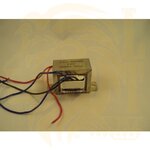ADGAN
Full Member level 5

- Joined
- Oct 9, 2013
- Messages
- 295
- Helped
- 4
- Reputation
- 8
- Reaction score
- 4
- Trophy points
- 18
- Activity points
- 1,837
Hi! In my application I used a 12V 300mA transformer, but when I connect a GSM modem it did not work after initialization. Many suggested that I should use a 12V 1A transformer. I want to know whether it will affect the rest of the circuit? (Whether other circuit components will get burnt)

